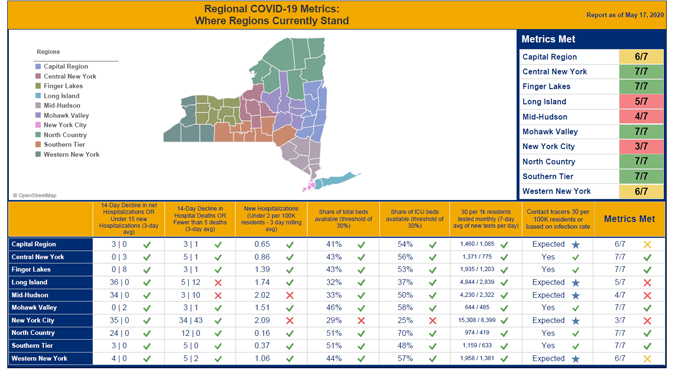
Governor Cuomo outlined a plan to reopen New York State. Our plan focuses on getting people back to work and easing social isolation without triggering renewed spread of the virus or overwhelming the hospital system.
New York will reopen on a regional basis as each region meets the criteria necessary to protect public health as businesses reopen.
The criteria consists of these metrics, which have been established based on guidance from the Center for Disease Control and Prevention, the World Health Organization, the U.S. Department of State, and other public health experts. For more information, read the NY Forward Book (https://www.governor.ny.gov/sites/governor.ny.gov/files/atoms/files/NYForwardReopeningGuide.pdf).
Metric #1— Decline in Total Hospitalizations. Region must show a sustained decline in the three-day rolling average of total net hospitalizations (defined as the total number of people in the hospital on a given day) over the course of a 14-day period. Alternatively, regions can satisfy this metric if the daily net increase in total hospitalizations (measured on a 3-day rolling average basis) has never exceeded 15. The first number in this cell represents the number of consecutive days of decline in the three-day rolling average of total net hospitalizations; if this number is 14 or greater the region automatically satisfies this metric. The second number represents the maximum daily net increase in total hospitalizations measured on a three day rolling average that the region has experienced; if this number is 15 or less the region automatically satisfies this metric.
Metric #2— Decline in Deaths. Region must show a sustained decline in the three-day rolling average of daily hospital deaths over the course of a 14-day period. Alternatively, regions can satisfy this metric if the three-day rolling average of daily new hospital deaths has never exceeded 5. The first number in this cell represents the number of consecutive days of decline in the three-day rolling average of daily hospital deaths; if this number is 14 or greater the region automatically satisfies this metric. The second number represents maximum daily increase in the three-day rolling average of new hospital deaths that the region has experienced; if this number is 5 or less the region automatically satisfies this metric.
Metric #3— New Hospitalizations. Region must experience fewer than 2 new hospitalizations per 100,000 residents, measured on a three-day rolling average. New hospitalizations include both new admissions and prior admissions subsequently confirmed as positive COVID cases.
Metric #4— Hospital Bed Capacity. Regions must have at least 30% of their hospital beds available.
Metric #5— ICU Bed Capacity. Regions must have at least 30% of their ICU beds available.
Metric #6— Diagnostic Testing Capacity. Average daily diagnostic testing over the past 7 days must be sufficient to conduct 30 tests per 1,000 residents per month.
Metric #7— Contact Tracing Capacity. Number of contact tracers in each region must meet thresholds set by the Department of Health, in collaboration with the Johns Hopkins University School of Public Health and Vital Strategies.
To keep everyone up to date on where things stand by region, New York has launched a new regional monitoring dashboard (https://forward.ny.gov/regional-monitoring-dashboard) that will be updated daily. Additionally, our NY Forward Reopening Plan, a clear and complete guide to reopening, offers a detailed look at the path forward. Together we flattened the curve and as we move into this next phase the same smart resolve, coupled with our commitment to each other, will get New York through.
https://www.governor.ny.gov/sites/governor.ny.gov/files/atoms/files/NYForwardReopeningGuide.pdf
Phased Reopening of Business
Each region will reopen businesses in phases, with at least two weeks in between each phase. This allows state and local leaders to monitor the effects of the reopening and ensure hospitalization and infection rates are not increasing before moving to the next phase and permitting more economic activity.
The phase-in plan prioritizes businesses considered to have a greater economic impact and inherently low risks of infection for the workers and customers, followed by other businesses considered to have less economic impact, and those that present a higher risk of infection spread.
Additionally, when phasing-in reopenings, regions must not open attractions or businesses that would draw a large number of visitors from outside the local area.
https://forward.ny.gov/industries-reopening-phase
Re-Opening of Beaches
State and local beaches can reopen Friday, May 22 in advance of Memorial Day, with reduced capacity and restrictions on large gatherings to avoid a resurgence of the coronavirus, Gov. Andrew M. Cuomo said.
Governor Cuomo’s order allows individual municipalities to opt to keep their beaches closed or to provide additional safety enhancements. The directive was coordinated with the governors of New Jersey, Connecticut and Delaware.
“If other states were opening and New York wasn’t, you would have had millions of people from New York flooding those beaches,” Cuomo said. “There would be a problem, and that wouldn’t help anyone.”
All four states will enforce the same rules, Cuomo said. Facilities cannot operate at more than 50% capacity, with limits enforced at entrances and parking lots, he said.
Swimming pools, playgrounds, arcades, rides, concession stands and picnic areas will remain shuttered, while contact activities such as volleyball and football will be prohibited. Social distancing rules will remain enforced, and staff will be required to wear masks, Cuomo said.
If a local government refuses to carry out the mandates, or cannot enforce the rules because of overcrowding, Cuomo said, “We will close the beach the next day.”

